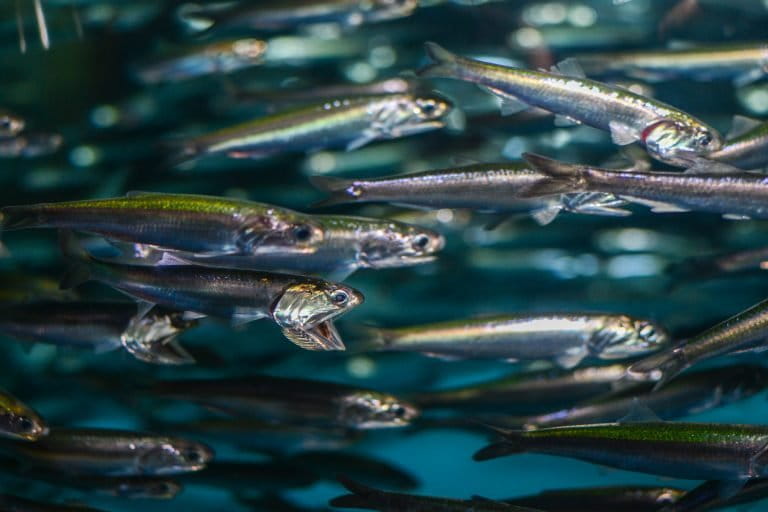- Researchers created blends of algae- and bacteria-coated plastic, clean plastic, and plain seawater to test whether anchovies are drawn to the scent of plastic debris in the ocean.
- The odors of plastic pieces coated in algae or bacteria sparked vigorous feeding behavior in the fish.
- By eating plastics, anchovies and other baitfish could become toxic to the animals and people who rely on them for food.
As plastic debris drifts through the ocean, it accumulates a coating of algae and bacteria. That coating smells delectable — that is, if you’re a fish.
Northern anchovies (Engraulis mordax) find the scent of “biofouled” plastic irresistible, according to a recent study published in the Proceedings of the Royal Society B. The silvery schooling fish detect the scent that marine algae and bacteria transfer onto bits of plastic, and launch into a flashing, darting feeding frenzy.
Anchovies are an ecologically and economically important species of baitfish in temperate waters worldwide. In the northern Pacific Ocean, they are food for whales, tuna and humans, among many other species. But if anchovies fill up with plastic, their consumers may have to contend with a new kind of junk in their food.

The paper’s lead author, Matthew Savoca, is a fellow at the U.S. National Oceanic and Atmospheric Administration in Monterey, California, researching the effects of pollution and litter on the ocean and its resources. His study is one of the first to demonstrate the importance of scent to fish like anchovies. And it reveals one reason that marine animals might be drawn to plastic in the first place.
“People try to make hypotheses about the color, shape and size of plastic pieces, but to me this [odor] hypothesis seems like one that was really important to test,” said ecologist Chelsea Rochman, an assistant professor at the University of Toronto, who was not involved in this study.
To determine if anchovies responded to plastics by smell, Savoca and his team created a strange collection of marine teas. They created different scented liquids by steeping biofouled plastic, clean plastic and krill. They released their brews, along with control samples of clean water, into schools of hundreds of anchovies, set up in tanks at the Aquarium of the Bay in San Francisco.
When the anchovies smelled either their favorite food — small swarming crustaceans called krill — or Savoca’s smelly plastic tea, they responded dramatically. “They darted and dashed in various directions, which is indicative of the foraging behavior of these animals,” Savoca said in an interview. “These fish are just going bananas for the food and the plastic, really.”

But when the fish smelled the clean plastic and plain water, they just kept swimming in their usual circles.
Savoca realized this behavior might historically have been helpful to the fish. “When animals eat plastic, they’re not actually making a dumb decision,” he pointed out. “It might smell like food, look like food, taste like food. It will be really hard for them to learn to reject this stuff as ‘not food.’”
One estimate from a 2015 study suggested that the rate of plastic entering the oceans worldwide in 2010 was roughly one dump truck load per minute. That added an estimated 8 million metric tons of plastic to the ocean that year alone. Despite some efforts, plastic production and pollution isn’t slowing down.

Savoca and other researchers are starting to examine the effects on fish fooled into eating biofouled plastic — and the possible consequences for their predators, such as whales.
Billions of people worldwide rely on seafood as their main protein source, Rochman noted, and their diet may be getting riskier. Plastics contain myriad harmful chemicals (with acronyms such as BPA and DEHP) that potentially move more easily into the bodies of fish through a coating of algae and bacteria. Humans, said Rochman, could start to find evidence of plastic-polluted water in their fillets and fish sticks.
“We have to act now when we’re seeing relatively small amounts of plastic in the animals we’re eating,” said Savoca. “This could become a problem of human health concerns and not just animal health concerns.”
CITATION
- Savoca MS, Tyson CW, McGill M, Slager CJ. (2017) Odours from marine plastic debris induce food search behaviours in a forage fish. Proceedings of the Royal Society B 284: 20171000. doi: 10.1098/rspb.2017.1000
Vicky Stein (@AgentRedSquirrl) is a graduate student in the Science Communication Program at the University of California, Santa Cruz. Other Mongabay stories by UCSC students can be found here.
